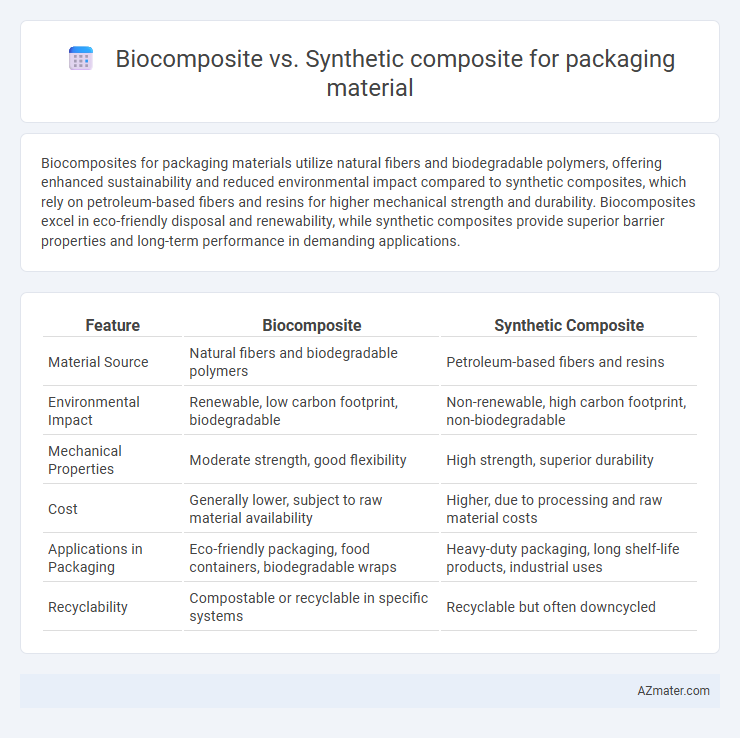Biocomposites for packaging materials utilize natural fibers and biodegradable polymers, offering enhanced sustainability and reduced environmental impact compared to synthetic composites, which rely on petroleum-based fibers and resins for higher mechanical strength and durability. Biocomposites excel in eco-friendly disposal and renewability, while synthetic composites provide superior barrier properties and long-term performance in demanding applications.
Table of Comparison
| Feature | Biocomposite | Synthetic Composite |
|---|---|---|
| Material Source | Natural fibers and biodegradable polymers | Petroleum-based fibers and resins |
| Environmental Impact | Renewable, low carbon footprint, biodegradable | Non-renewable, high carbon footprint, non-biodegradable |
| Mechanical Properties | Moderate strength, good flexibility | High strength, superior durability |
| Cost | Generally lower, subject to raw material availability | Higher, due to processing and raw material costs |
| Applications in Packaging | Eco-friendly packaging, food containers, biodegradable wraps | Heavy-duty packaging, long shelf-life products, industrial uses |
| Recyclability | Compostable or recyclable in specific systems | Recyclable but often downcycled |
Introduction to Packaging Materials
Biocomposite packaging materials, derived from natural fibers and biodegradable polymers, offer sustainable alternatives to traditional synthetic composites made from petroleum-based plastics. These biocomposites reduce environmental impact through enhanced biodegradability and lower carbon footprint while maintaining adequate mechanical properties for packaging applications. Synthetic composites, favored for their durability and moisture resistance, remain widely used but face increasing regulatory and consumer pressure to shift towards eco-friendly packaging solutions.
What Are Biocomposites?
Biocomposites are materials composed of natural fibers such as hemp, flax, or jute combined with a biodegradable or bio-based resin matrix, offering eco-friendly alternatives to traditional synthetic composites. These materials provide enhanced environmental benefits like reduced carbon footprint and improved recyclability compared to petroleum-based synthetic composites typically made from glass or carbon fibers embedded in polymer resins. In packaging applications, biocomposites contribute to sustainable practices by delivering biodegradability and reduced reliance on non-renewable resources while maintaining comparable mechanical strength and durability.
What Are Synthetic Composites?
Synthetic composites are engineered materials composed of a polymer matrix reinforced with fibers such as carbon, glass, or aramid, designed to offer high strength-to-weight ratios and enhanced durability. These composites are widely used in packaging applications requiring superior mechanical properties, chemical resistance, and extended shelf life. Unlike biocomposites, synthetic composites rely on non-renewable petrochemical sources, which can impact their environmental footprint despite their performance advantages.
Environmental Impact: Biocomposite vs Synthetic Composite
Biocomposites offer a significant environmental advantage over synthetic composites due to their biodegradability and reduced reliance on petroleum-based components, leading to lower carbon footprints and less landfill waste. Synthetic composites, composed primarily of non-renewable plastics and resins, contribute to microplastic pollution and persist in ecosystems for centuries, exacerbating environmental degradation. The use of biocomposites in packaging materials supports circular economy principles by enabling composting and resource regeneration, making them an eco-friendly alternative to traditional synthetic options.
Mechanical Properties Comparison
Biocomposites exhibit comparable tensile strength and stiffness to certain synthetic composites while offering enhanced biodegradability, making them suitable for sustainable packaging solutions. Synthetic composites typically provide higher impact resistance and greater durability under extreme environmental conditions, which is critical for heavy-duty packaging applications. The mechanical properties of biocomposites depend significantly on the type of natural fibers and matrix used, influencing factors such as flexural strength and elongation at break compared to synthetic composites like fiberglass or carbon fiber composites.
Cost Analysis and Market Trends
Biocomposites for packaging materials are gaining market traction due to increasing environmental regulations and consumer demand for sustainable options, with costs currently higher than synthetic composites but expected to decrease as production scales. Synthetic composites remain dominant in packaging due to lower initial costs, superior durability, and established supply chains, but face challenges from rising petroleum prices and regulatory pressures. Market trends indicate a gradual shift towards biocomposites driven by innovation in bio-based polymers and government incentives promoting eco-friendly packaging solutions.
Biodegradability and End-of-Life Scenarios
Biocomposites, derived from natural fibers and biodegradable polymers, offer significant advantages in biodegradability and sustainable end-of-life scenarios compared to synthetic composites made from petroleum-based plastics. Biocomposite packaging materials can decompose naturally in industrial composting facilities within months, reducing landfill accumulation and environmental pollution. In contrast, synthetic composites often persist for decades, requiring energy-intensive recycling or disposal methods, which contribute to long-term ecological harm.
Applications in the Packaging Industry
Biocomposites are increasingly favored in the packaging industry for their biodegradability and reduced environmental impact, making them ideal for food packaging, disposable containers, and sustainable wrapping materials. Synthetic composites, known for their superior mechanical strength and durability, are widely used in protective packaging and items requiring high performance under stress. The choice between biocomposite and synthetic composite depends on the application's sustainability goals, mechanical requirements, and product lifecycle considerations.
Consumer Perception and Acceptance
Consumer perception of biocomposite packaging materials is increasingly positive due to their eco-friendly attributes, such as biodegradability and reduced carbon footprint. Synthetic composites often face skepticism because of concerns over environmental impact and non-recyclability, despite their durability and cost-effectiveness. Market studies reveal higher acceptance rates for biocomposites in eco-conscious demographics, driving demand for sustainable packaging alternatives.
Future Outlook: Innovations and Sustainability
Biocomposites for packaging materials are advancing with innovations in biodegradable polymers and natural fiber reinforcements, enhancing mechanical strength and reducing environmental impact. Synthetic composites continue to evolve with improved recyclability and bio-based resin formulations, aiming to balance performance with sustainability. Future trends emphasize circular economy integration, prioritizing renewable resources, and minimizing carbon footprint in packaging solutions.

Infographic: Biocomposite vs Synthetic composite for Packaging material
 azmater.com
azmater.com